Posts: 1,827
Threads: 51
Joined: Apr 2012
Location: Oklahoma
02-13-2013, 09:17 AM
(This post was last modified: 02-13-2013, 09:23 AM by dallen.)
ran the numbers thru the big chief tablet and they said to use 0.875 for the 20 pitch wheels I had so I turned the 1" hunk of O1 drill rod down to 0.876 and ran the knurler up it and then back down after re tightening the adjusters.
First pass
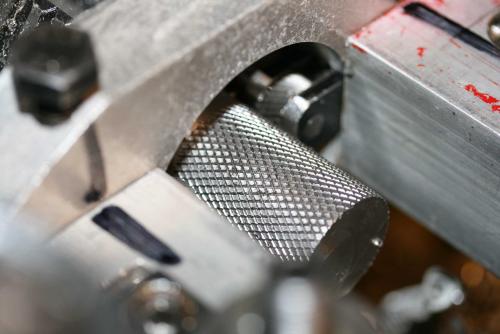
Second pass back over the first one after re tightening the adjusters I wasn't trying to get them needle sharp diamonds that will tear your finger prints off just a good grip.
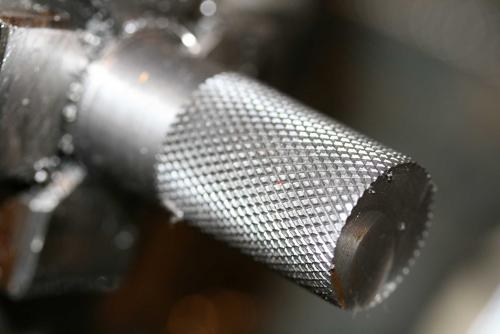
there are a couple things I will change if I make another one like a bigger bore in it and larger slots for the knurl shanks, but it sure beats the hell out of the other one I have. And I had the right diameter of stock for the pitch rolls that I ordered which stops the running over.
Here's a link to a youtube video that I used to calculate the Diameter for the rolls that I have.
http://www.youtube.com/watch?v=j4jIzRGAhvM
DA
dallen, proud to be a member of MetalworkingFun Forum since Apr 2012.
If life seems normal, your not going fast enough! 
Posts: 4,513
Threads: 139
Joined: Feb 2012
Location: Kempton Park. South Africa
DA,
That's a really nice looking knurl  

DaveH
Posts: 1,827
Threads: 51
Joined: Apr 2012
Location: Oklahoma
02-13-2013, 10:09 AM
(This post was last modified: 02-13-2013, 10:12 AM by dallen.)
(02-13-2013, 09:30 AM)DaveH Wrote: DA,
That's a really nice looking knurl  

DaveH
thanks, not to shabby for a homemade tool. Having the stock the right diameter helps out a lot in taking the guess work out of it turning out looking good or looking like its been running over itself.
DA
dallen, proud to be a member of MetalworkingFun Forum since Apr 2012.
If life seems normal, your not going fast enough! 
Posts: 3,795
Threads: 183
Joined: Jun 2012
Location: Farmington Hills, Michigan
Looks like that will do the job dallen.
I've never bothered with calculating the ideal diameters and have never had a problem with bad knurls, so I doubt that it's very critical. Working the numbers though, .875 is an ideal diameter for a 20 pitch (.05") knurl, or any diameter in increments of .016" either side of .875.
Tom
Posts: 3,002
Threads: 51
Joined: Apr 2012
Location: Ontario
Looks like it works perfectly! My knurls never turn out great, partly from using one of the ones that just push up against the work. How do you determine the pitch of the wheels so that I could try getting the dia right.
Free advice is worth exactly what you payed for it.
Greg
Posts: 3,795
Threads: 183
Joined: Jun 2012
Location: Farmington Hills, Michigan
Greg,
Multiply the diameter of your part by PI and divide by the tooth spacing of the knurl (1/pitch). If the result is close to a whole number you are good to go, otherwise, tweak the diameter until it is. As I said though, it's not very critical unless you are using a knurl with a very coarse pitch.
Tom
Posts: 3,002
Threads: 51
Joined: Apr 2012
Location: Ontario
Thanks, makes sense, divide the circumference by the tooth spacing, never gave it much thought before.
Free advice is worth exactly what you payed for it.
Greg
Posts: 11
Threads: 1
Joined: Jul 2012
Location: Warwickshire, UK
(02-13-2013, 09:17 AM)dallen Wrote: ran the numbers thru the big chief tablet and they said to use 0.875 for the 20 pitch wheels I had so I turned the 1" hunk of O1 drill rod down to 0.876 and ran the knurler up it and then back down after re tightening the adjusters.
Treating knurling as if you are cutting gears certainly works, but is entirely unnecessary.
The knurling wheels don't actually cut the metal, they mould it (yes, I know there is some powdery swarf generated, but it's nowhere near enough to fill the knurl pattern). As long as the next valley in the work-piece is deep enough to grip the next hill of the knurling wheel sufficiently to change its rotation speed, the knurl will be fine.
You do this by making sure that the initial impression is as deep as you can make it - you mustn't pussy-foot around treating it gently. Start off with as much pressure as you can manage, and the knurl pattern will establish itself beautifully.
With hard metals, such as steel, it can help if you start the knurl at the end of the bar with only an edge of the knurling wheel doing any work - you can get a good initial pressure this way that establishes the pattern which is nicely maintained when you move along the bar.
The following photos show the scissor knurling tool I designed and made, and some examples of knurls made with it - in aluminium, brass and steel.
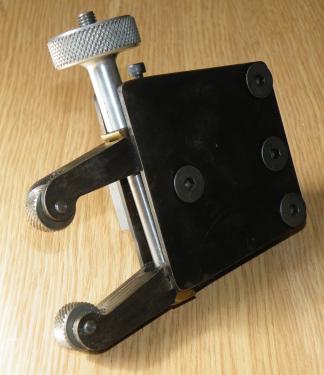
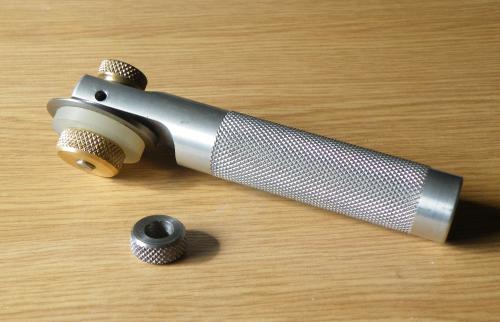
lemelman, proud to be a member of MetalworkingFun since Jul 2012.
Posts: 4,683
Threads: 93
Joined: Feb 2012
Location: Perth, Australia
Nice knurler lemelman.
There was a member on a forum that I can no longer access who made a camjack knurler, which I had planned to copy. From memory, the cam jack imparts greater pressure more easily when knurling hard material. It too is based on the scissor design.
Hunting American dentists since 2015.
Posts: 532
Threads: 39
Joined: Jan 2013
Location: Kelowna, BC, Canada
03-11-2013, 09:49 PM
(This post was last modified: 03-11-2013, 09:50 PM by Hawkeye.)
I'll write myself a note to post the Camjack Knurler here when I get the chance. I'd like to see a few more people try them out.
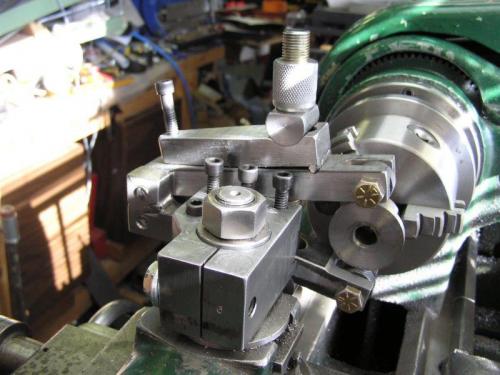
Mike
If you can't get one, make one.
Hawkeye, proud to be a member of MetalworkingFun Forum since Jan 2013.
|












![[Image: TomsTechLogo-Profile.png]](http://tomstechniques.com/wp-content/uploads/2013/11/TomsTechLogo-Profile.png)